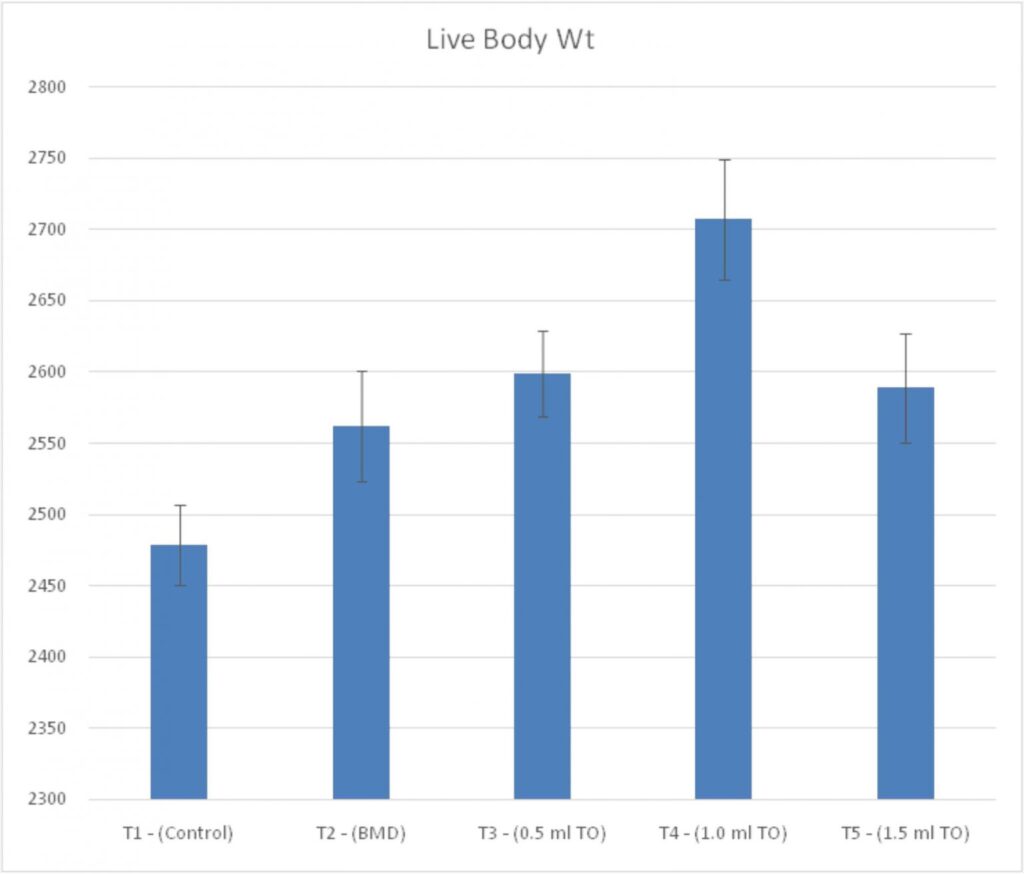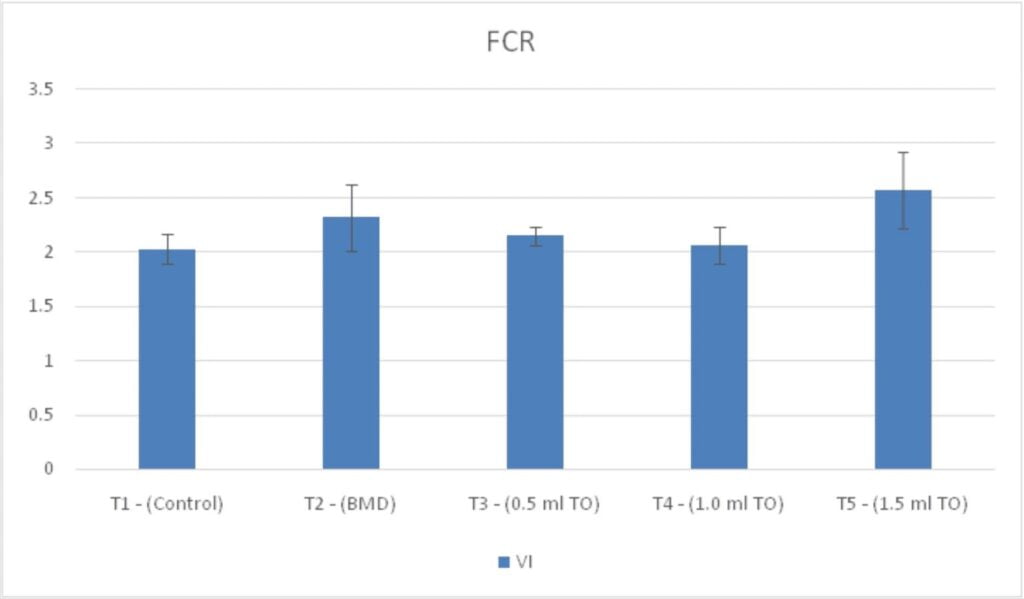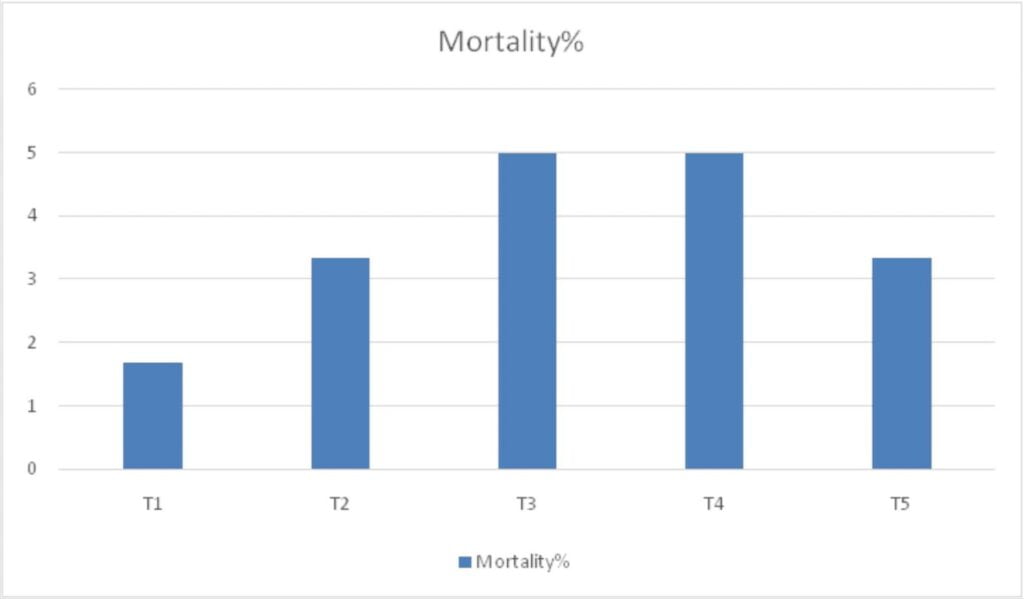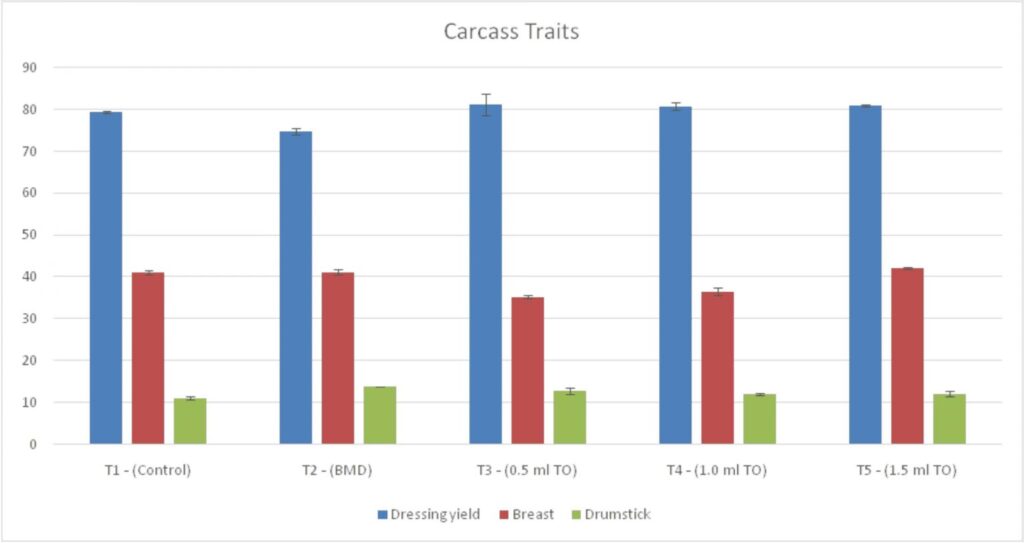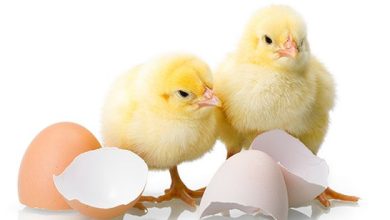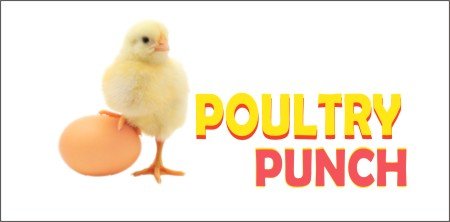Usage of Curcumol against Antibiotic Growth Promoters shows promising results in Broilers: A scientific research study

Dr Amrita Singh
BDM (Exports)
Innovista Feeding Solution Pvt. Ltd .
There is growing interest in developing natural alternatives to antibiotic growth promoters in order to maintain both birds’ performance and health. Natural compounds lack the undesirable effects that synthetic compounds can have on consumers which has caused the food industry to become increasingly interested in natural sources of substances (Singh et al., 2010). It has been stated that the supplementation of antibiotics in regular diet reduces the morbidity and mortality, as well as overall growth of broiler chickens. Using these commercially available antibiotics may show it adverse effect on the public health by developing the antibiotic resistant micro flora. Poultry industry needs to develop an alternative method to provide antibiotic potential to the chickens, in order to enhance the rate of production.
It is reported recently that turmeric falls in such class of medicinal plant that provides an alternative method of natural antibiotic to feed poultry farm. Turmeric is a natural herb of the ginger family, Zingiberaceae. Wide range medicinal properties of this plant have been advocated. Turmeric supplementation could effectively act on growthnand health status of chickens. Turmeric is one of the widely used and grown spices in India, which have attracted the attention of many researchers as an antimicrobial. Turmeric contains curcumin, a polyphenolic phytochemical bioactive compound, which showed anti-microbial, anti-inflammatory, anti-cancerous and anti-oxidant properties (Aggarwal and Harikumar, 2008 and Al-Sultan, 2003).
The present research was carried out on “Effect of Dietary Supplementation of Curcumin on Broiler Performance” at Poultry Research and Training Centre (PRTC), by Nikita Narendra Deshmukh at Post Graduate Institute of Veterinary and Animal Sciences, Akola under Maharashtra Animal and Fishery Sciences University, (MAFSU) Nagpur, Maharashtra (India) for six weeks period w.e.f. 27th January 2021 to 10th March 2021. Turmeric oil which is used as the source of curcumin was procured from M/s Innovista Feeding Solutions Private Limited, Kolkata, West Bengal as Cucumol.
Three hundred day old chicks were distributed into five treatment groups, randomly with each treatment having three replicates of 20 chicks each. In control group (T1) birds were offered basal diet as per BIS (2007). In group T2 basal diet with antibiotic of BMD group was added, groups T3, T4 and T5 were offered basal diet added with 0.5ml, 1ml and 1.5ml Curcumol/kg feed, respectively. Weekly live body weight and feed residual for weekly feed intake was calculated every week. In 6th week one bird from each group was slaughtered for evaluation of carcass and gut health parameters.
Table 1 The details of different dietary treatments using turmeric oil
| Treatment groups | Details of Treatments | No. of birds/ replicate | No. of replicates/ treatment | No. of birds/ treatment |
| T1 | Control diet | 20 | 3 | 60 |
| T2 | Basal diet containing antibiotic growth promoter of BMD* group | 20 | 3 | 60 |
| T3 | Basal diet added with 0.5ml turmeric oil containing 6% curcumin / kg feed | 20 | 3 | 60 |
| T4 | Basal diet added with 1ml turmeric oil containing 6% curcumin / kg feed | 20 | 3 | 60 |
| T5 | Basal diet added with 1.5ml turmeric oil containing 6% curcumin / kg feed | 20 | 3 | 60 |
*Bacitracin methylene di-salicylate (0.5g /kg diet)

Groups fed diet added with turmeric oil had improved live body weights at sixth week of age, with highest live body weight observed in group T4 as shown in table below:
Table 2 Weekly live body weights (g/b) of broilers fed different levels of turmeric oil
| Treatment group | Age (in weeks) | ||||||
| Day old | I | II | III | IV | V | VI | |
| T1 – (Control) | 41.72 ± 0.43 | 149.78 ± 2.42c | 418.03 ± 6.94b | 819.86 ± 12.62 | 1335.84 ± 17.15 | 1889.61 ± 30.81b | 2479 ± 28.27c |
| T2 – (BMD) | 42.08 ± 0.49 | 160.83 ± 3.10b | 449.48 ± 8.81a | 827.49 ± 16.86 | 1376.58 ± 28.86 | 2107.97 ± 37.68a | 2562.40 ± 38.74bc |
| T3 – (0.5 ml TO) | 41.46 ± 0.38 | 159.73 ± 2.81b | 452.66 ± 6.97a | 832.45 ± 12.47 | 1394.71 ± 20.83 | 2142.13 ± 36.70a | 2598.87 ± 29.99b |
| T4 – (1.0 ml TO) | 41.43 ± 0.43 | 162.78 ± 2.67ab | 448.98 ± 8.19a | 828.21 ± 16.49 | 1381.71 ± 19.80 | 2174.91 ± 37.31a | 2707.36 ± 42.47a |
| T5 – (1.5 ml TO) | 42.72 ± 0.48 | 169.28 ± 2.62a | 458.88 ± 6.43a | 838.28 ± 15.08 | 1395.33 ± 20.45 | 2196.67 ± 36.778a | 2588.97 ± 37.98b |
| CD | NS | 13.195** | 20.788** | NS | NS | 103.616** | 99.181** |
| CV% | 8.223 | 7.579 | 13.038 | 13.680 | 12.026 | 13.579 | 10.535 |
a, b, c Means with different superscripts in a column differ significantly. **P<0.01, *P<0.05, NS-Non-significant TO- turmeric oil, BMD- Bacitracin methylene di- salicylate
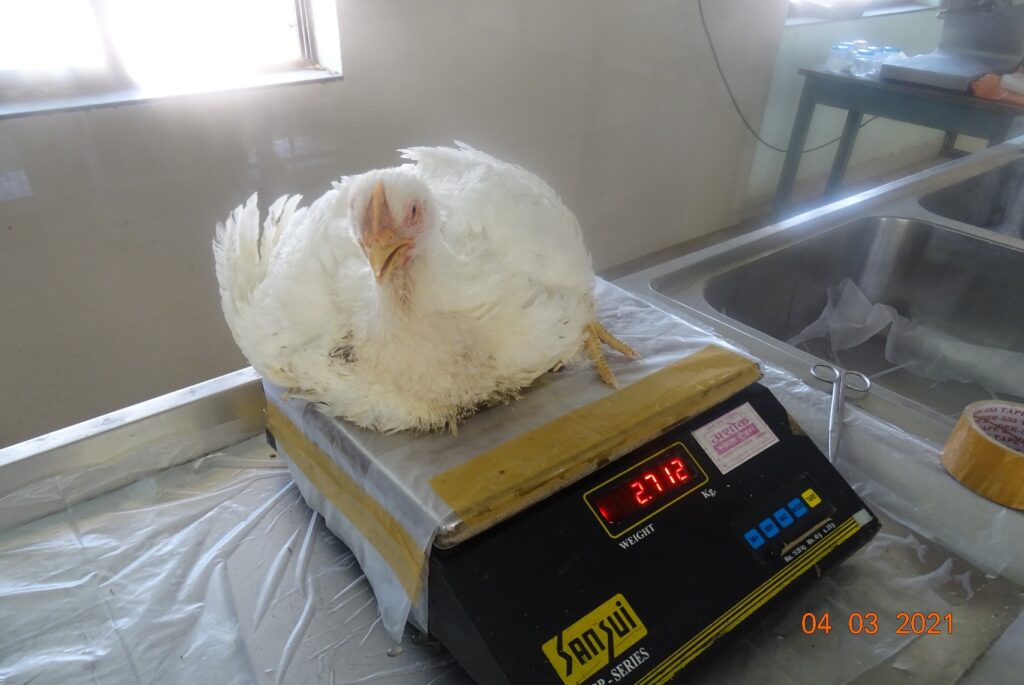
Following is the graphical representation of the same:
Weight gain was higher in all turmeric oil added diet groups with highest in group T4 as shown in table below:
Table 3 Weekly weight gain (g/b) of broilers fed different levels of turmeric oil
| Treatment group | Age (in weeks) | |||||
| I | II | III | IV | V | VI | |
| T1 – (Control) | 108.07 ± 1.44b | 268.25 ± 8.07 | 401.72 ± 6.13 | 516.71 ± 34.77 | 537.53 ± 32.72 | 605.31 ± 31.11 |
| T2 – (BMD) | 118.76 ± 4.27ab | 288.52 ± 11.18 | 378.79 ± 18.25 | 548.52 ± 47.56 | 730.38 ± 84.45 | 455.50 ± 73.47 |
| T3 – (0.5 ml TO) | 118.28 ± 4.14ab | 292.93 ± 5.57 | 379.68 ± 12.72 | 559.30 ± 50.77 | 750.58 ± 67.61 | 456.95 ± 3.84 |
| T4 – (1.0 ml TO) | 121.35 ± 4.60a | 290.65 ± 12.30 | 378.79 ± 18.56 | 554.38 ± 45.29 | 790.83 ± 53.08 | 535.88 ± 57.42 |
| T5 – (1.5 ml TO) | 126.56 ± 1.38a | 292.45 ± 3.39 | 379.40 ± 20.12 | 560.34 ± 33.39 | 799.45 ± 52.91 | 394.39 ± 49.80 |
| CD | 10.974* | NS | NS | NS | NS | NS |
| CV% | 5.081 | 5.294 | 7.227 | 13.577 | 14.556 | 17.446 |
a, b, c Means with different superscripts in a column differ significantly. **P<0.01, *P<0.05, NS-Non-significant, TO- turmeric oil, BMD- Bacitracin methylene di- salicylate
Following is the graphical representation of the same:
Weekly feed conversion was seen numerically lower in group T4 during overall trial period shown in table below.
Table 4 Weekly FCR of broilers fed different levels of turmeric oil
| Treatment group | Age (in weeks) | |||||
| I | II | III | IV | V | VI | |
| T1 – (Control) | 1.13 ± 0.02 | 1.38 ± 0.06 | 1.33 ± 0.04 | 1.58 ± 0.10 | 1.83 ± 0.13 | 2.03 ± 0.14 |
| T2 – (BMD) | 0.98 ± 0.07 | 1.42 ± 0.05 | 1.30 ± 0.07 | 1.50 ± 0.16 | 1.82 ± 0.25 | 2.32 ± 0.31 |
| T3 – (0.5 ml TO) | 1.02 ± 0.06 | 1.36 ± 0.07 | 1.36 ± 0.07 | 1.55 ± 0.18 | 1.74 ± 0.12 | 2.15 ± 0.08 |
| T4 – (1.0 ml TO) | 0.98 ± 0.02 | 1.38 ± 0.04 | 1.31 ± 0.13 | 1.52 ± 0.15 | 1.68 ± 0.16 | 2.06 ± 0.17 |
| T5 – (1.5 ml TO) | 0.98 ± 0.01 | 1.37 ± 0.04 | 1.34 ± 0.06 | 1.5 ± 0.12 | 1.64 ± 0.14 | 2.57 ± 0.35 |
| CD | NS | NS | NS | NS | NS | NS |
| CV% | 7.275 | 6.574 | 9.819 | 16.668 | 16.873 | 18.217 |
a, b, c Means with different superscripts in a column differ significantly, NS-Non-significant, TO- turmeric oil, BMD- Bacitracin methylene di-salicylate
Following is the graphical representation of the same:
Mortality percent was recorded below standard range. The table below shows the results:
Table 5 Percent mortality in broilers fed turmeric oil added feed at various levels under different dietary treatment groups
| Treatment groups | No. of birds | No. of birds died | Mortality% | Livability
% |
| T1 | 60 | 1 | 1.67 | 98.33 |
| T2 | 60 | 2 | 3.33 | 96.67 |
| T3 | 60 | 3 | 5 | 95 |
| T4 | 60 | 3 | 5 | 95 |
| T5 | 60 | 2 | 3.33 | 96.67 |
| Total no. of birds | 300 | 11 | 3.67 | 96.33 |
Following is the graphical representation of the same:
Carcass traits were seen to be significantly affected by treatment. Improved dressing percentage, edible percentage and breast percentage were observed in diet added with turmeric oil. Dressing and edible percentage were recorded highest in group T3 and breast percentage was highest in group T5 which was given Curcumol.
Table 6 Carcass traits and cut up parts (%) in broilers fed different levels of turmeric oil
| Treatment groups | Dressing yield | Giblet yield | Eviscerated yield | Carcass cut up parts (% live weight) | |||||
| Breast | Thigh | Drumstick | Back | Neck | Wings | ||||
| T1 – (Control) | 79.34 ± 0.29a | 3.81 ± 0.08 | 75.53 ± 0.22a | 41.16 ± 0.55a | 13.02 ± 1.00 | 11.14 ± 0.35c | 15.07 ± 0.13 | 5.63 ± 0.22 | 7.25 ± 0.10b |
| T2 – (BMD) | 74.79 ± 0.72b | 4.18 ± 0.03 | 70.62 ± 0.72b | 41.22 ± 0.66a | 14.98 ± 0.46 | 13.83 ± 0.11a | 16.85 ± 0.15 | 6.48 ± 0.62 | 9.87 ± 0.34a |
| T3 – (0.5 ml TO) | 81.25 ± 2.64a | 4.38 ± 0.19 | 76.86 ± 2.47a | 35.26 ± 0.37b | 14.15 ± 1.43 | 12.81± 0.80ab | 17.02 ± 0.50 | 6.90 ± 0.17 | 9.39 ± 0.15a |
| T4 – (1.0 ml TO) | 80.78 ± 0.87a | 4.23 ± 0.10 | 76.54 ± 0.81a | 36.64 ± 0.86b | 13.75 ± 1.43 | 12.12± 0.28bc | 17.06 ± 0.88 | 6.85 ± 0.75 | 10.61 ± 0.14a |
| T5 – (1.5 ml TO) | 80.91 ± 0.21a | 4.35 ± 0.15 | 76.56 ± 0.16a | 42.18±0.246a | 14.44 ± 0.10 | 12.10± 0.68bc | 15.72 ± 0.70 | 6.51 ± 0.70 | 9.75 ± 1.11a |
| CD | 4.082* | NS | 3.806* | 1.829** | NS | 1.619* | NS | NS | 1.666* |
| CV% | 2.822 | 5.189 | 2.776 | 2.558 | 12.721 | 7.166 | 5.899 | 14.732 | 9.791 |
a, b, c Means with different superscripts in a column differ significantly **P<0.01 and *P < 0.05. NS- Non-significant TO- turmeric oil, BMD- Bacitracin methylene di- salicylate.
Following is the graphical representation of the same
The highest net income per kg live body weight was recorded in group T4 fed with 1ml of turmeric oil followed by group T3 and T4 offered 0.5ml and 1.5 ml turmeric oil as shown in table below:
Table 7 Economics:
| T1 | T2 | T3 | T4 | T5 | ||
| 1. | Return on sale Rs. 80 per kg body weight | 198.32 | 204.96 | 207.92 | 216.56 | 207.12 |
| 2. | Net profit per bird (Rs.) | 35.34 | 33.95 | 40.37 | 45.79 | 39.19 |
| 3. | Net profit per kg (Rs.) | 14.26 | 13.25 | 15.53 | 16.92 | 15.14 |
We concluded from this research study that Curcumols addition at 1ml/kg diet improved broiler performance, carcass traits, gut health and profit return in broiler production as compared to regular AGPs usage. Cumulative weight gain was higher in all turmeric oil added diet groups with highest in group T4. Enhanced feed intake was recorded in group T4 having 1ml turmeric oil/kg feed. Cumulative weekly feed conversion was seen numerically lower in group T4 during overall trial period. Mortality percent was recorded below standard range. The total coliform count was significantly reduced in turmeric oil added groups with lowest seen in group T5. Carcass traits were seen to be significantly affected by treatment. Improved dressing percentage, edible percentage and breast percentage were observed in diet added with turmeric oil. Dressing and edible percentage were recorded highest in group T3 and breast percentage was highest in group T5. The cost economics showed a higher net profit per bird in group provided feed added with 1ml turmeric oil/kg basal diet.
